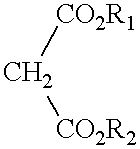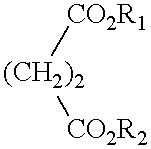Intercalates and exfoliates formed with monomeric ethers and esters; composite materials containing same methods of modifying rheology therewith
a monomer ether and ester technology, applied in the field of intercalated layered materials and exfoliates, can solve the problems of little success, time-consuming and difficult sorption, and inability to exfoliate intercalated materials,
- Summary
- Abstract
- Description
- Claims
- Application Information
AI Technical Summary
Benefits of technology
Problems solved by technology
Method used
Image
Examples
example 2
Preparation of Clay--Monomeric Ether Complexes (Intercalates)
Materials:
Clay--sodium montmorillonite;
Monomeric Ether: diethylene glycol; triethylene glycol; polyethylene glycol (number of monomer units in polymer=2-10); ethylene glycol vinyl ether; ethylene glycol divinyl ether; propyl vinyl ether; 1,4 butanediol vinyl ether; 1,4 butanediol divinyl ether; and mixtures thereof.
To prepare Clay (sodium montmorillonite)--Monomeric ether complexes (intercalates) three different processes are used for ether intercalation:
1. Mixture of the 2% ether / water solution with the 2% clay / water suspension in a ratio sufficient to provide an ether concentration of at least about 8% based on the dry weight of the clay.
2. Dry clay powder is gradually added to the 2% ether / water solution in a ratio sufficient to provide a ether concentration of at least about 8% based on the dry weight of the clay.
3. Dry clay is moisturized with ether / water solution to 20-80% by weight water, and then extruded.
The mixtu...
PUM
| Property | Measurement | Unit |
|---|---|---|
| thickness | aaaaa | aaaaa |
| thickness | aaaaa | aaaaa |
| temperature | aaaaa | aaaaa |
Abstract
Description
Claims
Application Information
 Login to View More
Login to View More - R&D
- Intellectual Property
- Life Sciences
- Materials
- Tech Scout
- Unparalleled Data Quality
- Higher Quality Content
- 60% Fewer Hallucinations
Browse by: Latest US Patents, China's latest patents, Technical Efficacy Thesaurus, Application Domain, Technology Topic, Popular Technical Reports.
© 2025 PatSnap. All rights reserved.Legal|Privacy policy|Modern Slavery Act Transparency Statement|Sitemap|About US| Contact US: help@patsnap.com



